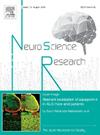Optineurin knock-out forms TDP-43 aggregates to regulate TDP-43 protein levels despite autophagic up-regulation and aberrant TDP-43 expression
IF 2.4
4区 医学
Q3 NEUROSCIENCES
引用次数: 0
Abstract
Optineurin is a causative gene of amyotrophic lateral sclerosis (ALS) and has many roles in processes such as autophagy and inflammation. However, it is unclear how optineurin causes ALS. Optineurin knock-out (Optn-KO) mice, which have been generated by several researchers, exhibit motor neuron degeneration and TDP-43 aggregates, but no motor deficits. Motor dysfunction in ALS model mice is associated with TDP-43 in the spinal cord. We bred Optn-KO mice with TDP-43 overexpression transgenic mice and evaluated whether increased TDP-43 protein causes motor deficits and whether Optn-KO affects TDP-43 protein level. Optn-KO mice had spinal TDP-43 protein levels and motor function comparable to wild-type mice, and TDP-43-transgenic (TDP-43-tg) mice resulted in motor dysfunction and early death. However, double-mutant TDP-43-tg / Optn-KO mice had lower TDP-43 protein levels than TDP-43-tg mice at 18 months age, and showed inhibition of the TBK1-optinerurin autophagic pathway with aging. Furthermore, Optn-KO caused TDP-43-positive cytoplasmic aggregates. TDP-43 overexpression by itself induced spinal microgliosis, but Optn-KO suppressed that microgliosis. Finally, we showed that Optn-KO mice could not exhibit behavioral dysfunction because TDP-43 protein levels were not elevated despite autophagy inhibition. Thus, downregulation of Optn may suppress TDP-43 toxicity by regulating its abundance through aggregate formation.
尽管自噬上调和TDP-43表达异常,optinineurin敲除形成TDP-43聚集体来调节TDP-43蛋白水平。
optinneurin是肌萎缩性侧索硬化症(ALS)的致病基因,在自噬和炎症等过程中发挥多种作用。然而,目前尚不清楚优神经蛋白是如何引起ALS的。Optineurin敲除(Optn-KO)小鼠,由几位研究人员产生,表现出运动神经元变性和TDP-43聚集,但没有运动缺陷。肌萎缩侧索硬化症模型小鼠的运动功能障碍与脊髓中TDP-43的表达有关。我们将TDP-43过表达转基因小鼠与Optn-KO小鼠杂交,观察TDP-43蛋白升高是否会导致运动障碍,以及Optn-KO是否会影响TDP-43蛋白水平。Optn-KO小鼠的脊髓TDP-43蛋白水平和运动功能与野生型小鼠相当,TDP-43转基因(TDP-43-tg)小鼠导致运动功能障碍和早期死亡。然而,双突变TDP-43-tg / Optn-KO小鼠在18月龄时的TDP-43蛋白水平低于TDP-43-tg小鼠,并且随着年龄的增长,TBK1-optinerurin自噬途径受到抑制。此外,Optn-KO引起tdp -43阳性的细胞质聚集。TDP-43自身过表达诱导脊髓小胶质瘤形成,而Optn-KO抑制脊髓小胶质瘤形成。最后,我们发现Optn-KO小鼠不会表现出行为障碍,因为尽管自噬受到抑制,但TDP-43蛋白水平并未升高。因此,下调Optn可能通过聚集体形成调节TDP-43的丰度来抑制TDP-43的毒性。
本文章由计算机程序翻译,如有差异,请以英文原文为准。
求助全文
约1分钟内获得全文
求助全文
来源期刊

Neuroscience Research
医学-神经科学
CiteScore
5.60
自引率
3.40%
发文量
136
审稿时长
28 days
期刊介绍:
The international journal publishing original full-length research articles, short communications, technical notes, and reviews on all aspects of neuroscience
Neuroscience Research is an international journal for high quality articles in all branches of neuroscience, from the molecular to the behavioral levels. The journal is published in collaboration with the Japan Neuroscience Society and is open to all contributors in the world.
 求助内容:
求助内容: 应助结果提醒方式:
应助结果提醒方式:


